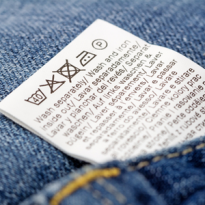What Information Do You Need To Include On Wash Care Labels?
Posted on 25/07/2017 in Product Information, by Jon

The Ultimate Guide to Wash Care Labels
Wash care labels are present on nearly every piece of clothing or textile product, providing essential information on how to properly care for the item. They help protect both the product and the consumer by outlining the necessary steps for washing, drying, and ironing.
Creating your own wash care label might seem like a challenge, but it’s important to ensure the correct information is included. This guide explains the essential details that need to be on your wash care label, ensuring both compliance with UK regulations and helpful guidance for your customers.
1. Fibre Content
What It Is:
Fibre content refers to the percentage of each fibre used to create the garment. For example, a shirt may be made from 50% cotton and 50% polyester.
Why It’s Important:
In the UK, fibre content is a legal requirement in the apparel and textiles industry. This information helps consumers avoid allergic reactions and ensures they know exactly what materials they are wearing.
Legal Requirements:
- Must be stated in a language understandable by the consumer.
- If you’re selling internationally (e.g., in Spain), the fibre content must be printed in the local language, such as Spanish.
Example:
A wool-blend sweater may be labeled as:
“80% Wool, 20% Nylon”
2. Country of Origin
What It Is:
The country of origin tells consumers where the product was made. This can be a simple statement or a flag, for example, “Made in the UK” or “Made in Italy.”
Why It’s Important:
While the country of origin is generally not mandatory in the EU, misleading information about where the product was made is illegal. If your product is British-made, it’s beneficial to highlight this, as it can boost consumer trust and promote local manufacturing.
Example:
- “Made in the UK”
- “Made in Italy”
3. Wash Care Labelling
What It Is:
Wash care labels provide instructions on how to properly care for your product—covering washing, drying, ironing, and professional cleaning. These instructions are typically represented by symbols that help consumers understand how to maintain their garment without damaging it.
Why It’s Important:
- Not a legal requirement in the UK but strongly encouraged.
- Without these instructions, consumers might unknowingly damage the product by improper washing or drying. This could lead to a bad experience with your brand.
Symbol Categories:
Wash care symbols fall into five key categories:
- Washing
- Bleaching
- Drying
- Ironing
- Professional Care (e.g., dry cleaning)
Example:
- Washing Symbol: A tub of water with a number inside indicates the temperature for machine washing (e.g., a number “30” means 30°C).
- Ironing Symbol: An iron with dots indicates the temperature setting. One dot represents low heat, while three dots represent high heat.
For a detailed guide to the symbols, then read our post here.
4. Hazard Instructions
What It Is:
Certain products, such as nightwear for children, are required by UK law to carry flammability information. For example, children’s nightwear must meet the British Standard 5722, which specifies flammability requirements.
Why It’s Important:
If your product poses a specific hazard (e.g., fire risk), this must be clearly marked to ensure customer safety. This is especially crucial for extreme sports clothing or garments that could pose safety risks.
Example:
- Nightwear for children: “This garment meets British Standard 5722 for flammability.”
- Extreme Sports Wear: “This product is fire-resistant and complies with EU regulations.”
5. Size
What It Is:
While not legally required, size is crucial information for ensuring your customers know whether a garment will fit. Sizes can be provided as standard labels (e.g., Small, Medium, Large) or with numerical measurements (e.g., UK 8, 10, 12 for women’s clothing).
Why It’s Important:
Providing size information ensures customers can make informed decisions, especially in an online retail environment where trying on the garment isn’t possible.
Example:
- Standard: “Size: Medium”
- Numerical: “Size: UK 10”
Conclusion: The More Information, The Better
While only a few aspects of the wash care label are legally required, providing as much helpful information as possible will improve your customers’ experience and trust in your brand. Using clear and concise symbols is a great way to include all the necessary details without overwhelming the label with text.
Additional Tips:
- Consistency is Key: Make sure all of your products follow the same labelling format, especially if you sell multiple product lines.
- Stay Updated: Regulations around care labelling may evolve, so make sure to stay informed about any updates, particularly if you’re expanding internationally.
If you need assistance with creating or updating your wash care labels, our team is here to help. Get in touch today to discuss how we can support your product labelling needs.

